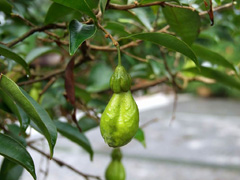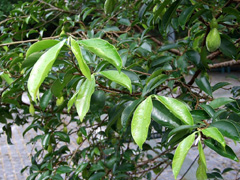 |
|
https://commons.wikimedia.org/wiki/User:Chong_Fat |
 |
| https://commons.wikimedia.org/wiki/User:Chong_Fat |
Translate this page:
Summary
One of the three species of the Aquilaria genus that are great sources of a resin used as perfume and incense is Agar Wood or Aquilaria sinensis. It is a tropical, evergreen tree that grows up to 15 m tall and is found in East Asia. It is also widely cultivated for its wood and fibre. Due to such highly valuable uses, the tree has been over exploited in the wild. Alike to Aquilaria crassna and Aquilaria malaccensis, Aquilaria sinensis is used medicinally to lower fever and as relief from spasms. The incense is as well used against cancer, abdominal pains, asthma, colic, and diarrhoea. The wood, on the other hand, can be grated and prepared in various ways for treating small pox, rheumatism, and abdominal pains. Wood decoction has anti-microbial properties.
Physical Characteristics

 Aquilaria sinensis is an evergreen Tree growing to 15 m (49ft) by 12 m (39ft) at a slow rate.
Aquilaria sinensis is an evergreen Tree growing to 15 m (49ft) by 12 m (39ft) at a slow rate.
See above for USDA hardiness. It is hardy to UK zone 10.
Suitable for: light (sandy), medium (loamy) and heavy (clay) soils, prefers well-drained soil and can grow in heavy clay and nutritionally poor soils. Suitable pH: mildly acid, neutral and basic (mildly alkaline) soils. It cannot grow in the shade. It prefers moist soil.
UK Hardiness Map
US Hardiness Map
Synonyms
Agallochum sinense (Lour.) Kuntze Aquilaria grandiflora Benth. Aquilaria ophispermum Poir. Ophisperm
Plant Habitats
Edible Uses
References More on Edible Uses
Medicinal Uses
Plants For A Future can not take any responsibility for any adverse effects from the use of plants. Always seek advice from a professional before using a plant medicinally.
Antiasthmatic Antidiarrhoeal Antirheumatic Aphrodisiac Astringent Cancer Carminative Febrifuge
Stimulant Tonic
Agar is an astringent, stimulant, tonic herb that relieves spasms, especially of the digestive and respiratory systems, and lowers fevers[ 238 ]. In Western, Chinese and Indian medicines the incense is used against cancer, especially of the thyroid gland. In China it is applied as a sedative against abdominal complaints, asthma, colic and diarrhoea, and as an aphrodisiac and carminative[ 310 ]. The grated wood enters into various preparations used especially during and after childbirth, and to treat rheumatism, smallpox and abdominal pains. Decoctions of the wood are said to have anti-microbial properties, e.g. Against Mycobacterium tuberculosis and Shigella flexneri[310
References More on Medicinal Uses
The Bookshop: Edible Plant Books
Our Latest books on Perennial Plants For Food Forests and Permaculture Gardens in paperback or digital formats.

Edible Tropical Plants
Food Forest Plants for Hotter Conditions: 250+ Plants For Tropical Food Forests & Permaculture Gardens.
More

Edible Temperate Plants
Plants for Your Food Forest: 500 Plants for Temperate Food Forests & Permaculture Gardens.
More

More Books
PFAF have eight books available in paperback and digital formats. Browse the shop for more information.
Shop Now
Other Uses
Containers Cosmetic Fibre Incense Repellent Resin String Weaving Wood
Other uses rating: Medium (3/5). Other Uses Agar wood is the rare and famous, resin-containing heartwood that is produced mainly from old and diseased trees of several members of this genus[ 310 ]. In trade a distinction between the wood from these species is rarely made[ 310 ]. The fragrance produced by the burning agar wood has been highly valued for thousands of years, and its use as incense for ceremonial purposes in Buddhism, Confucianism and Hinduism is widespread throughout eastern and southern Asia. In Thailand it is put into funeral pyres, while in Japan, the incense is used in tea ceremonies[ 310 ]. Wood only partly saturated with resin but still fragrant, and occasionally also the wood remaining after distillation, is made into sticks called 'joss-sticks' or 'agarbattis' which are burnt as incense[ 310 ]. The incense is also used as an insect repellent[ 310 ]. Agar-wood oil is an essential oil obtained by water and steam distillation of agar wood. It is used in luxury perfumery for application in e.g. oriental and woody-aldehydic bases, 'chypres' and 'fougeres'. It produces interesting odour notes with clove oil, e.g. in carnation bases. The oil is so rare and expensive that it is only produced on request[ 310 ]. Agar-wood oil is a yellow to dark amber, viscous liquid with a characteristic balsamic and woody odour. Its aroma has some resemblance with vetiverol or styrax and has a sweetness similar to that of sandalwood oil. Its odour is long-lasting and exhibits a good tenacity in applications[ 310 ]. The silvery inner bark can be removed from the trunk in a single large sheet[ 310 ]. It is highly valued for its strength and durability and is made into cloth and ropes[ 310 ]. It is also made into writing material which was formerly only used for chronicles of important events and religious books[ 310 ]. The timber of undiseased trees, known as 'karas', is soft and very light with a density of about 400 kg/m3 air dry. It is creamy white to pale yellowish-brown or greyish-brown, heartwood and sapwood not clearly differentiated[ 310 ]. The texture is rather coarse and the wood diffuse-porous. It is suitable for making boxes, light indoor construction and veneer[ 310 ]. The scented wood differs from the normal wood due mainly to deposition of an aromatic resin. The resin is concentrated in the included phloem strands. Because of the resin content the scented wood is relatively hard, brittle and heavy[ 310 ].
Special Uses
Scented Plants
References More on Other Uses
Cultivation details
Grows best in undulating terrain in the moister lowland tropics, being found at elevations of 200 - 700 metres[ 310 ]. It prefers an annual rainfall of 1,500 - 6,500 mm, a mean annual maximum temperature of 22 - 28c and a mean annual minimum temperature of 14 - 21c[ 310 ]. Prefers heavy soils developed from gneiss and other metamorphic rocks, but it also grows well on sandy loams developed from sandstone[ 310 ]. The extremely high prices paid for high quality agar wood and for the essential oil and the indiscriminate felling of both diseased and healthy trees threaten natural stands of Aquilaria including Aquilaria sinensis to extinction. Research into possibilities of artificial induction and stimulation of agar wood formation is therefore urgently required and may offer high economic returns, especially as trials indicate that management of plantations presents no great difficulties. Unless such methods are developed, Aquilaria malaccensis may soon be extinct[ 310 ]. Plantations have been established, mainly for experimental purposes, to test methods for the induction of agar wood formation[ 310 ]. Three closely related species of Aquilaria are considered to be the major sources of agar wood and are distinguished by the length of their calyx lobes:- Aquilaria crassna, which comes from Indo-China, has lobes 12 - 15mm long. Aquilaria malaccensis, from India, and Malaysia has lobes 2 - 3mm long. Aquilaria sinensis, from China, has lobes 8mm long. A number of other species are less important sources of agar wood, including some minor Aquilaria spp., Enkleia malaccensis and the timbers Gonystylus bancanus and G. macrophyllus[ 310 ]. Agar wood formation is a pathological process taking place in the stem or main branches where an injury has occurred. Fungi are involved in the process, but the process itself is not yet fully understood. Damage by boring insects is often associated with the infection. It is believed that the tree is first attacked by a pathogenic fungus, which causes it to weaken. Infection by a second fungus causes the formation of agar wood, but it is unclear whether it is a product of the fungus or the tree. The fungus implicated in the formation of agar wood in A. malaccensis is Cytosphaera mangiferae, while Melanotus flavolives is assumed to play a similar role in this species[ 310 ].
References Carbon Farming Information and Carbon Sequestration Information
Temperature Converter
Type a value in the Celsius field to convert the value to Fahrenheit:
Fahrenheit:
The PFAF Bookshop
Plants For A Future have a number of books available in paperback and digital form. Book titles include Edible Plants, Edible Perennials, Edible Trees,Edible Shrubs, Woodland Gardening, and Temperate Food Forest Plants. Our new book is Food Forest Plants For Hotter Conditions (Tropical and Sub-Tropical).
Shop Now
Plant Propagation
Seed should be sown immediately, as it remains viable for only about 1 month. It is sown in nursery beds, about 5 mm deep in a mixture of soil, sand and manure and kept under light shade. Germination starts after 10 - 12 days and is normally complete after 1 month[ 310 ]. Seed sown immediately after collection has about 65% germination, falling to 45% after 1 week and only 5% after 3 weeks in storage[ 310 ]. The seedlings are very prone to insect attack[ 310 ]. Seedlings are pricked out into containers 40 - 45 days after germination when they are 3 - 5 cm tall, and are kept under shade[ 310 ]. They are ready for transplanting when 30 - 35 cm tall and 10 - 12 months old[ 310 ]. Transplanting bare-rooted seedlings has been tried successfully in some areas[ 310 ]. Fruit harvested for seed should be collected when mature but still green. A medium- sized tree produces about 2,000 seeds per year, but seed production may fluctuate greatly between years[ 310 ]. The fruits are dried in the shade for about 2 days, they then burst and release the seed[ 310 ].
Other Names
If available other names are mentioned here
Agar Wood, Pak Muk Heung, White Wood Incense
Native Range
TEMPERATE ASIA: China (Fujian Sheng, Guangdong Sheng, Guangxi Zhuangzu Zizhiqu, Hainan Sheng)
Weed Potential
Right plant wrong place. We are currently updating this section.
Please note that a plant may be invasive in one area but may not in your area so it's worth checking.
None Known
Conservation Status
IUCN Red List of Threatened Plants Status : Vulnerable

Growth: S = slow M = medium F = fast. Soil: L = light (sandy) M = medium H = heavy (clay). pH: A = acid N = neutral B = basic (alkaline). Shade: F = full shade S = semi-shade N = no shade. Moisture: D = dry M = Moist We = wet Wa = water.
Now available:
Food Forest Plants for Mediterranean Conditions
350+ Perennial Plants For Mediterranean and Drier Food Forests and Permaculture Gardens.
[Paperback and eBook]
This is the third in Plants For A Future's series of plant guides for food forests tailored to
specific climate zones. Following volumes on temperate and tropical ecosystems, this book focuses
on species suited to Mediterranean conditions—regions with hot, dry summers and cool, wet winters,
often facing the added challenge of climate change.
Read More
Expert comment
Author
(Lour.) Spreng.
Botanical References
Links / References
For a list of references used on this page please go here
A special thanks to Ken Fern for some of the information used on this page.
Readers comment
| Add a comment |
|
If you have important information about this plant that may help other users please add a comment or link below. Only comments or links that are felt to be directly relevant to a plant will be included. If you think a comment/link or information contained on this page is inaccurate or misleading we would welcome your feedback at [email protected]. If you have questions about a plant please use the Forum on this website as we do not have the resources to answer questions ourselves.
* Please note: the comments by website users are not necessarily those held by PFAF and may give misleading or inaccurate information.
To leave a comment please Register or login here All comments need to be approved so will not appear immediately.
|
Subject : Aquilaria sinensis
|
|
|
|